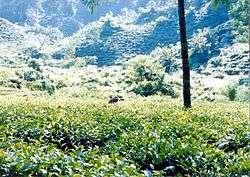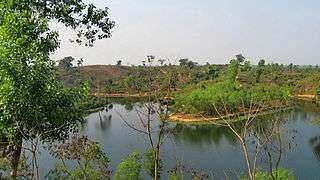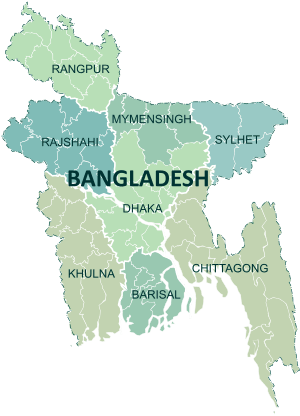Moulvibazar District
| Moulvibazar মৌলভীবাজার | |
|---|---|
| District | |
|
Tea gardens of Sreemangal in Moulvibazar district | |
 Location of Moulvibazar in Bangladesh | |
| Country |
|
| Division | Sylhet Division |
| Area | |
| • Total | 2,799.38 km2 (1,080.85 sq mi) |
| Population (2011 census) | |
| • Total | 1,919,062 |
| • Density | 690/km2 (1,800/sq mi) |
| Time zone | BST (UTC+6) |
| Postal code | 3200 |
| Website |
www |
Moulvibazar (Bengali: মৌলভীবাজার জেলা Moulbibazar Zila), also called Maulvibazar,[1] Moulavibazar,[2] and Maulavibazar,[3] is a district of Sylhet Division in North-Eastern Bangladesh.
Etymology
The name of the district, Moulvibazar is derived from two words, Moulvi and bazar, meaning "Market of the Moulvi". Moulvi (Mawlawi) is an honorific Islamic title and 'bazar' is the Persian word for market or township. Moulvibazar is named after Hazrat Syed Moulvi Qudratullah Munsef, the descendant of Hazrat Syed Shah Mustafa 'Sher-E-Sowar' Chabukmar Baghdadi, an Islamic preacher active during the advent of Islam in the region. It is believed that the name was coined in the middle of 17th century when Moulvi Qudratullah established a small bazaar near his house and local people named it as Moulvibazar. This market was established at riverside of the present Poschim Bazar (West Market), which gradually expanded over the time. [4] [5]
Geography
Moulvibazar is in Sylhet, a district to the North-East of Bangladesh. It is 2,707 km² in area, and has a population of 1.38 million. It is situated between 24.10 degree 24.35 degree north latitude and between 90.35 degree and 91.20-degree east longitude. It is surrounded by Sylhet District in the north, Habiganj District in the west and Indian States of Assam and Tripura in the east and south respectively.
The main rivers of the district are the Manu, the Dholoi and the Juri which flow from India. Every year during the rainy season, when there is excessive rainfall in India, the surplus water flows through these rivers and causes floods in low-lying parts of Moulvibazar (for example, the villages of Balikhandi and Shampashi on the northern side of the river Manu). Unless the rivers are properly dredged the floods can be devastating.
In the last few years Moulvibazar has had a muti-million dollar flood defence system built, which is the only one like it in the whole country.
Upazila (subdivisions)
Moulvibazar is made up of 7 subdivisions or upazilas. They are: Moulvibazar Sadar, Barlekha, Juri, Kamalganj, Kulaura, Rajnagar, and Sreemangal.
There are 67 Unions, 2,064 Villages and 5 Pourashavas namely Kamalganj, Kulaura, Sreemongal, Barlekha and Moulvibazar. Almost 50,000 of the clan population belong to Manipuri, Khasia and Tripura clans. They tend to live in the areas of Kamalganj, Sreemongal and Kulaura Upazila of this district. There are 92 tea gardens in this district that has made it one of the most beautiful places in Bangladesh.
History
Islam was introduced to the region by the revered preacher Hazrat Shah Jalal and his companions.
In 1882, the present-day Moulvibazar was first demarcated as a sub-division (administrative unit) as 'South Sylhet' by the British imperial government. The name reverted to 'Moulvibazar' during the Pakistan era. On 6 December 1971, the occupying Pakistan military administration surrendered Moulvibazar to the joint forces of the Mukti Bahini (Freedom Forces) and the Indian Army. Bangladesh freedom fighter (or rebel combatant, depending on perspective) Rana Choudhury was present on behalf of the Mukti Bahini.
In 1984, the then President H. M. Ershad upgraded the status of Moulvibazar in administrative hierarchy from 'sub-division' to a 'district'.
Economy

The main exports of Moulvibazar are bamboo, tea, pineapple, cane, jackfruit, oranges, agar, rubber, mangoes and lemons. Ninety-one of Bangladesh's 153 tea gardens are located in Moulvibazar. The area is also home to the three largest tea gardens (size and production wise) in the world. Pineapples from the Sreemangal area are famous for their flavour and natural sweetness. Sreemongal is known as the 'tea capital of Bangladesh' due to the high frequency of tea plantations found there.
Religion
The district of Moulvibazar consists 2967 mosques, 613 temples, 56 churches and 22 Buddhist temples.
Transport
The main transport systems used in the city are Cycle rickshaws, auto rickshaws (mainly known as baby-taxis or CNGs), buses, mini-buses and cars. There are about 10,000 rickshaws running each day. Bus service prices have increased as of 2008, up to 30% higher, prices ranges from Tk4 to 25.95.[6] The Kulaura Railway Station, Sreemangal Railway Station is the main railway station providing trains on national routes operated by the state-run Bangladesh Railway. Also Bhanugach Railway Station, Tilagaon, Vatera, Rashidpur Station is used by local peoples.
Places of interest

The shrine of Shah Mustafa, a companion of Shah Jalal, the man who brought Islam into what was then India, is here. It is also home to many tea plantations. Moulvibazar town now has a shopping mall and several Indian, Chinese and American eateries. Madhabkunda waterfall at Barlekha and 'Ham Ham waterfall' at Kamalgonj are among the enchanting places of the district. Hakaluki Haor, 'Hail Haor' Madhobpur Lake', 'Bilashchhara Lake', 'Lawachara National Park' in Kamalganj upazilla are other places of interest in the district.
See also
References
- ↑ Shah Abdul Wadud (2012). "Maulvibazar District". In Sirajul Islam and Ahmed A. Jamal. Banglapedia: National Encyclopedia of Bangladesh (Second ed.). Asiatic Society of Bangladesh.
- ↑ "List of Institutes in Moulavibazar District". Government of the People's Republic of Bangladesh, Directorate General of Health Services. Retrieved 27 Aug 2013.
- ↑ "Estimates of Aman Rice, 2012-2013" (PDF). Bangladesh Bureau of Statistics Agriculture Wing. Retrieved 27 Aug 2013.
- ↑ Editorial Board (September 1996). ISLAMI BISHWAKOSH: The Encyclopedia of Islam in Bengali, 21st Volume. Dhaka, Bangladesh: Islamic Foundation, Bangladesh. pp. 448–452.
- ↑ Website, Moulvibazar (January 2016). "Introduction". Moulvibazar. Retrieved 4 September 2016.
- ↑ Sylhet city bus services hike fares on whim New Age Metro. 4 November 2008. Retrieved on 25 May 2009.
| Wikimedia Commons has media related to Maulvi Bazar District. |
- Moulvibajar Jilar Itihas o Oitisyo, Rabbani Choudhury, Agami Prokashon, 2000
- Kazi Mahmudur Rahman, Faculty (Mentors' education Moulvibazar branch)




